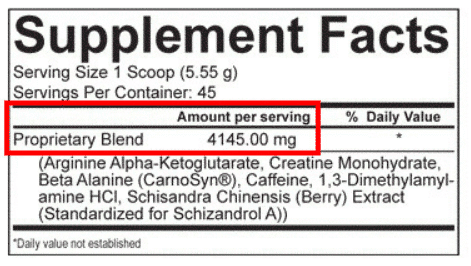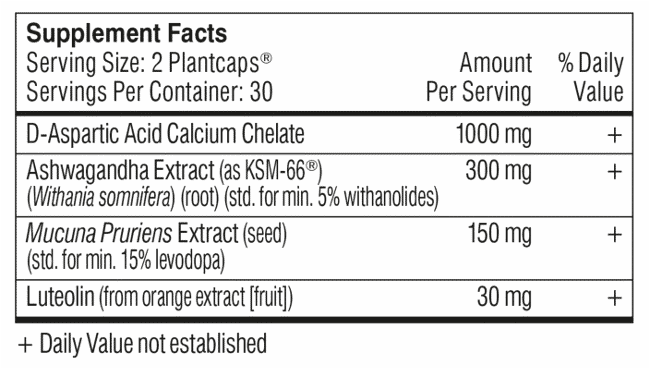If you’ve ever taken a supplement, you’ve probably seen a proprietary blend or two without even knowing it. Supplements aren’t like food, so the ingredients label doesn’t have to disclose as much information as a nutritional facts panel on a food product.
Instead, supplement companies can hide their exact formulas under the guise of a proprietary blend, only showing the total weight of the combination of ingredients, not the weight of each ingredient in the blend.
What is a proprietary blend?
A proprietary blend is a grouping of multiple ingredients listed as a “matrix” or “complex” by a supplement company or manufacturer. Supplement companies like to use fancy words to hype up proprietary blends, like “Exploding Pump Complex” or “Extreme Hypertrophy Matrix”.

While this sounds great, all a proprietary blend does is hide to dosing of the individual ingredients from the user and the company’s competitors. However, the lack of transparency can lead to under-dosing without the consumer, even knowing.
Therein lies the issue; you, as a consumer, want to know exactly what you ingest.
Why would a supplement company use a proprietary blend?
There is essentially one reason why a reputable supplement company would use proprietary blends.
The proprietary blend may be a trademarked blend of ingredients that have been studied. For example, an anti-oxidant supplement may contain SPECTRA, a trademarked proprietary blend of ingredients that have been studied and shown positive results as a whole.

A supplement using this blend isn’t allowed to disclose the weight of each of the individual ingredients found in SPECTRA, but the consumer can rest assured that it will still work as advertised because studies use that exact blend of ingredients with positive outcomes.
Other than that specific reason, many supplement companies can use proprietary blends to trick uninformed buyers:
- Proprietary blends can easily be underdosed. Since only the total weight of the whole group of ingredients is listed, it’s essentially impossible to know the exact dose of each ingredient.
- Proprietary blends may raise the cost of the supplement when a company decides to throw multiple ingredients in the mixture to look more effective. Sometimes this increases the price without an increase in results.
- Using proprietary blends can also lower the cost for the production of the supplement since it can be easily underdosed. This means more profit in the pockets of the deceiving supplement companies.
Why you should avoid them
The idea behind a proprietary blend sounds legitimate: a way to hide a specific formula of ingredients so that the competition can remake the product and sell for a lower price.
However, in reality, the rampant use of proprietary blends have made tricking the consumer with improper dosing, and useless ingredients make proprietary blends a lousy choice for someone looking to get the best bang for their buck.
1) Unproven ingredients
Like we mentioned earlier, some companies throw a ton of ingredients in a proprietary blend to raise the potential value of the supplement, since it looks more advanced to have more ingredients.
The problem with this is that many of those ingredients are unproven and become a waste of money. Unstudied ingredients also have the lack of a comprehensive safety profile, so you don’t know what long term use could potentially do to your health.
It’s best to stick with well-studied ingredients that are proven to produce results. Some examples are Creatine, Caffeine, and Fish Oils.
If an ingredient hasn’t been studied more than 1-2 times, it isn’t proven, and it isn’t worth your money.
2) Not clinically dosed
Proprietary blends can be made from proven ingredients. However, dosing still may be less than optimal.
If you don’t know what you are taking, you shouldn’t use that product.
To get the best results from a supplement, you need to be taking optimal doses of all the ingredients. Studies show optimal doses of ingredients, and most proprietary blends contain much less than what you need.
The only thing you can deduce from a proprietary blend is which ingredients are in higher amounts. A proprietary blend lists each ingredient from highest weight to lowest.
For example, a “Muscle-Maximizing Blend” containing five total grams of Creatine, Citrulline, and Beta-Alanine means that there is more Citrulline than Beta-Alanine and more Creatine than Citrulline.
It looks excellent since those ingredients have all been shown to produce great results. However, the 5g total weight is not high enough to include the optimal doses of those three ingredients.
3) Unknown mechanism of action

The problem with trademarked proprietary blends that have been studied as a whole is that you don’t know what each ingredient brings to the table. Some of the ingredients may even be useless and do nothing but increase the cost of production, which translates to a higher price to the consumer.
For example, looking at the SPECTRA blend we talked about earlier, there are many different fruit and vegetable compounds in the blend. However, it’s impossible to tell which of the ingredients are providing the best results and which aren’t doing much at all.
Not knowing which specific ingredient does what makes it much easier for supplement companies to charge more for their products, since they might include multiple ingredients that are unnecessary, in addition to the ones that work well.
4) Untrustworthy company
Studies reveal the effective dose of ingredients, and the information is freely available.
Supplement companies still producing proprietary blends for the sake of hiding their “top-secret” formula from their competitors are just hoping to fool the buyer.
Consider this: a product contains 5g of Creatine, 6g of Citrulline Malate, 3g of Beta-Alanine, and 2g of L-Carnitine-L-Tartrate will be a highly effective supplement for improving strength and endurance. No company needs to hide this information behind a proprietary blend because the effective dose of each ingredient is easily found with a simple search online.
Instead, companies still use proprietary blends for the sake of secrecy, when it’s just a tool to lower production costs with lower total amounts of each ingredient. Then, they turn around and charge extra because of their new “matrix” that claims to add lbs of muscle every single week.
5) Hard to track progress
Some supplements are taken multiple times a day. Others require higher doses overtime to compensate for tolerance.
When a supplement contains a proprietary blend, you have no idea how much you are currently taking or how much you need to add on to increase your results.
Not following a proper dosing schedule of ingredients means you aren’t going to progress as much as you could.
How should you choose your supplement company instead?
There are many companies out there, aiming to help consumers instead of trick them. Fancy label designs and sponsoring great fitness models isn’t what makes a supplement company the right choice.
Here are a few things to look for to maximize the value of your purchase.
1) Transparency
The Supplements Facts label should list every single ingredient’s weight. This ensures the optimal dosing is present in the supplement.

The best thing about this is that most companies providing fully transparent ingredient panels dose precisely how they should since there is nothing left to hide behind.
A transparent label will list each ingredient on one line with its specific dose. Or, it may even contain a fancy-sounding “complex” that looks like a proprietary blend but still includes the dosage of each ingredient in the grouping.
For example, if you look at the highly popular Pre-Kaged pre-workout from Kaged Muscle, you will see it contains a “Strength and Power Matrix” containing Beta-Alanine, Betaine, and Creatine. But, instead of listing the total weight of all the ingredients combined, the label still lists each ingredient’s weight.
2) Scientifically proven
While some proprietary blends have been studied and shown to work (like the SPECTRA blend mentioned earlier) most are unstudied and ineffective.
You should purchase supplements from companies that use scientifically validated ingredients through multiple studies.
Yes, new ingredients look enticing and sound exciting. However, most of them don’t stack up to the classics.
That’s why we don’t see a bunch of new ingredients stand the test of time. Most of them sell in massive quantities when first introduced and get quickly forgotten when the new shiny ingredient comes out in a few months.
3) Clinically dosed
Many supplement ingredients can work very well. However, a great ingredient that is under-dosed won’t work or is not as effective.
It’s as simple as that. You need the right amount of the right ingredients to produce results.
1g of Creatine every day won’t provide the same results as 3-5g will. 1g of Citrulline Malate before a workout won’t affect performance like a 6-8g will.
If an ingredient looks promising in research, it needs to be used in those doses to produce the same results for you.
4) No proprietary blends
It’s easy to tell that we aren’t fans of proprietary blends. We won’t recommend that you go with a company that uses them.
Instead, find a company that cares enough about its consumers that they list out each ingredient and its dosage.
No more hiding, it’s time for the consumer to get what they are paying for: transparency and results!
The bottom line
The supplement industry isn’t highly regulated. Any average Joe could go out and start a supplement line and hide behind proprietary blends.
However, we as consumers can’t fall for these tricks anymore. We want results, so we need to focus on supporting the supplement companies that have our best interests in mind.









Add Comment